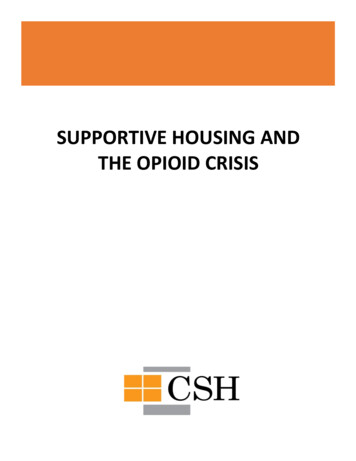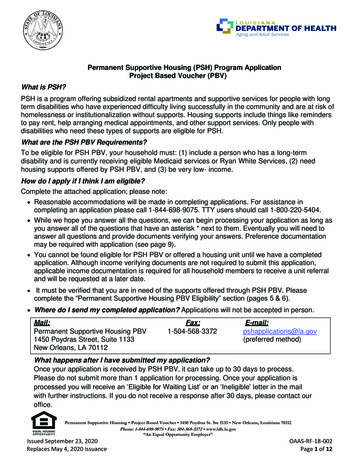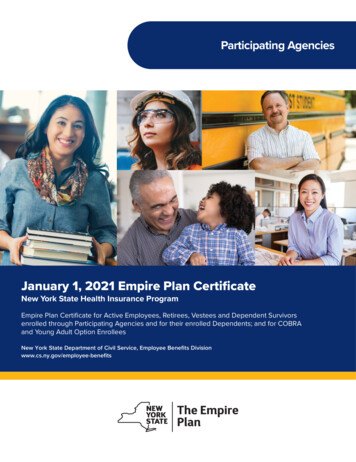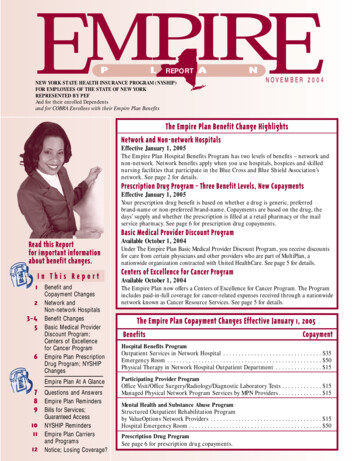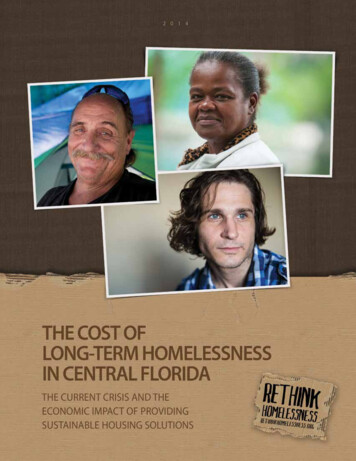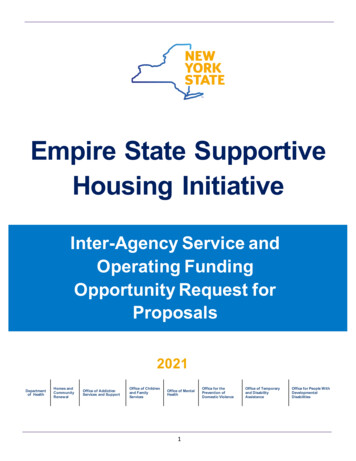
Transcription
Empire State SupportiveHousing InitiativeInter-Agency Service andOperating FundingOpportunity Request forProposals2021Departmentof HealthHomes andCommunityRenewalOffice of AddictionServices and SupportOffice of Childrenand FamilyServicesOffice of MentalHealth1Office for thePrevention ofDomestic ViolenceOffice of Temporaryand DisabilityAssistanceOffice for People WithDevelopmentalDisabilities
ContentsSECTION 1: Introduction .41.1 Services and Operating Funding Parameters.81.2 Term of Contract .101.3 Eligible Applicants .101.4 Eligible Target Population.111.4.1 Living Situations at Time of Referral . 121.4.2 Medicaid Redesign Team (MRT) High-Cost, High-Need Medicaid Users . 121.5 Award Allocations by Population Categories .131.6 Eligible Costs .131.7 Ineligible Expenses .141.8 Reporting and Operating Requirements.151.9 Standard Contract Language.151.10 Executive Order Number 38 – Limits on State-funded Admin Costs and Executive Compensation .151.11 Executive Order Number 190 - Incorporating Health Across All Policies into State Agency Activities .151.12 Contract Readiness .161.13 Minority and Women Owned Business Enterprises.171.13.1 Business Participation Opportunities for MWBEs . 171.13.2 Equal Employment Opportunity Requirements . 191.14 Participation by Service-Disabled Veterans with Respect to State Contracts Through Set Asides.191.15 Sexual Harassment Prevention Certification.21SECTION 2: General Requirements .212.1 Desired Goals and Program Requirements .212.2 Key Events/Timeline .222.3 Proposal Submittal Process .222.3.1 Register for the Grants Gateway. 232.3.2 Complete your Prequalification Application. 232.3.3 Submit Your Prequalification Application . 232.4 Questions and Answers.242.5 Webinar .242.6 Selection Criteria.252.7 Charities Registration .272.8 Vendor Responsibility Requirements.272.9 Interagency Workgroup and State Contracting Agency Rights.282.10Iran Divestment Act.302
2.11Addenda to Request for Proposals.30SECTION 3: Debriefing.30SECTION 4: Formal Protest Procedure.31SECTION 5: Glossary.31SECTION 6: Application Instruction Requirements .35PREVIEW OF GRANTS GATEWAY APPLICATION .39Appendix A.43Medicaid Redesign Team Supportive Housing Project Questionnaire .433
Empire State Supportive Housing Initiative (ESSHI)Inter-Agency Service and Operating Funding OpportunityRequest for ProposalsSECTION 1: IntroductionNew York has led the nation in affordable housing preservation and construction. The StateFiscal Year 2021-22 Enacted Budget continues funding to advance Governor Cuomo’scomprehensive plan for affordable and supportive housing to ensure New Yorkers have access tosafe and secure housing. The State has committed this funding in order to create or preserveaffordable and supportive housing units.New York will invest a portion of these resources to specifically address vulnerable populationsexperiencing homelessness. To ensure the maximum benefit of this investment, the State willutilize the existing federal Department of Housing and Urban Development (HUD) Continuum ofCare (CoC) model that engages localities and not-for-profit (NFP) providers in developing andimplementing data-driven strategies to address homelessness in specific populations such asvictims of domestic violence, runaway and homeless youth and formerly incarcerated individuals(see Section 1.4 for full list of eligible target populations). The State intends to develop a total of20,000 units over a period of 15 years. As such, the State is issuing this Request for Proposals(RFP) to advance the goal of developing 1,400 units of supportive housing annually for personsidentified as homeless with special needs, conditions or other life challenges.Each applicant will be required to demonstrate that their proposal is consistent with their mostrecent HUD CoC data or other local data and have the support of their local CoC or local planningentity. Support from the local CoC or local planning entity does not need to be site specific.However, the support letter should indicate the need for and support of a project serving theproposed population within the CoC’s jurisdiction. CoCs or local planning entities are notexpected to prioritize proposals. Applicants should communicate with the local planning entityboth prior to the submission of the proposal and throughout the development process.Applicants should demonstrate how the proposal meets the gap that is identified in the CoC reportor other local data, where available. For those populations not typically included in the CoC, theproposal should demonstrate involvement with local levels of planning to ensure that necessarylocal engagement processes have been completed, and may include supplemental local, state,and/or federal data.Sixty percent of the scoring of this RFP will be assigned based upon how the proposal addresseslocally specific needs. Cost effectiveness and readiness comprise the balance of the elements onwhich the scoring will be based .The State has continuously assessed the breakdown of units awarded by region of the state andspecial needs group they are serving to ensure that awards are being disbursed according toareas and groups with greatest need. Based on this assessment, this RFP emphasizes thedevelopment of permanent supportive housing for underserved populations including chronicallyhomeless persons, families, individuals, and/or young adults that have mental health and/or4
substance use disorders, and victims/survivors of domestic violence. Applications where greaterthan 50% of the ESSHI units are dedicated to these populations will be eligible to receive morepoints than those that do not.Supportive HousingPart of New York State’s Housing Plan includes an investment of new supportive housingresources and services to address vulnerable populations experiencing homelessness. Therefore,the availability of and access to various support services such as employment and trainingopportunities, parenting education, counseling, independent living skills training, primaryhealthcare, substance use disorder treatment and mental health care, child care, and benefitsadvocacy are critical components of any project funded under this plan. The support servicesprovided should be tailored and appropriate to the specific population to be served (e.g., safetyplanning for victims of domestic violence, treatment for a substance use disorder, etc.).Services should be appropriate to a supportive housing model. A policy of harm-reduction isexpected. All services should be voluntary and there should be no requirements that a tenantbe drug or alcohol free before renting, or while renting, a unit. Drug/alcohol testing is notacceptable. ESSHI projects are expected to follow a Housing First model (see glossary), whichhas been shown to be an effective approach to reducing chronic homelessness, as well asreducing barriers to permanent supportive housing.Staff should have the skills, qualifications and experience necessary to help the head ofhousehold set meaningful goals and make progress toward achieving them. The services can beprovided on- or off-site (or a combination of both), and either directly by the applicant or throughpartnerships with other community-based agencies (or a combination of both).Note that this initiative focuses only on permanent supportive housing as defined in the attachedglossary. Transitional and emergency housing beds are not eligible.Service and Operating Funding ProcessThe following describes the focused, transparent and accountable approach that the State will takein allocating the services and operating funds so that the State’s health and human servicesproviders receive the assistance they need to house the vulnerable populations they serve.The New York State Office of Mental Health (OMH) will serve as the lead procurement agency forthis RFP under the guidance of the ESSHI Interagency Workgroup (the “Workgroup”). Although theOMH is the lead, proposals accepted through this RFP opportunity do not have to be for services topersons with mental illness but should address the range of needs of the populations served by thefollowing agencies. The Workgroup includes representatives from several State agenciesincluding: Department of Health (DOH) including the AIDS Institute; New York State Homes and Community Renewal (HCR); Office of Addiction Services and Supports (OASAS); Office of Children and Family Services (OCFS); Office of Mental Health (OMH); Office for the Prevention of Domestic Violence (OPDV); Office of Temporary and Disability Assistance (OTDA); and5
Office for People with Developmental Disabilities (OPWDD).Funding for 1,400 qualifying individuals will be awarded through this sixth-round RFP. There is nominimum or maximum number of units that applicants may apply for.For purposes of the ESSHI RFP, “qualifying individual” has the same meaning as “unit,” as in unitof cost. Projects may receive up to 25,000 per qualifying individual/unit. For example, a twobedroom apartment may serve one “qualifying individual” living with a partner or children. Forsome, but not all populations, a two-bedroom apartment may serve two “qualifying individuals”. Ineither scenario, 25,000 is the maximum request for each qualifying individual. So, the firstexample would qualify for up to 25,000 of ESSHI funds and the second example, up to 50,000.Note that the term “unit” with respect to permanent supportive housing funded under NYS capitalprograms continues to refer to a distinct, physical dwelling unit. Note further that certainagencies, such as OASAS and OPDV do not allow multiple qualifying individuals in the samedwelling unit. Similarly, it is the expectation of HCR that each qualifying individual would occupy asingle housing unit. The terms “application(s)” and “proposal(s)” are used interchangeablythroughout this RFPTime Frame for Securing Capital Financing:Linking capital projects with the needed service and operating funding is a stated objective of thisRFP. Therefore, applicants are expected to secure capital funding sufficient to fully finance thehousing project for which they are requesting ESSHI funding through this RFP within 24 monthsfrom the date of the ESSHI conditional funding award. “Securing” of a capital award can bedemonstrated by submission of an award letter or evidence of a decision by a granting agency(e.g. HHAC, HTFC, HFA). If after 24 months from the date of the conditional service and operatingfunding award, the applicant has not successfully secured commitments for the capital financingnecessary for the project, the conditional ESSHI award will expire. Any uncommitted awardamounts may be added to the pool of available funding and made available in accordance with theterms of this RFP.Applicants who currently have a conditional award and are unable to secure 100% of the capital forthe project by expiration date should consider reapplying if ESSHI funds are still contemplated forthe project. It is the intention of the Workgroup to continue issuance of an annual RFP despite theextension of the conditional award period to 24 months. Please note a prior conditional award doesnot guarantee a new conditional award resulting from this solicitation.In the event a capital award is rescinded, any ESSHI award made available through this RFP mayalso then be rescinded. If the ESSHI award is rescinded, the applicant will be notified in writing ofthis decision and informed of the ability to reapply during the next RFP opportunity. Any applicantthat fails to obtain capital within the 24-month time frame, resulting in the expiration of itsconditional ESSHI award, will also be eligible to re-apply for service and operating funding duringsubsequent RFP opportunities.Extensions of Conditional Awards:The Workgroup has the option, in limited situations, to provide extensions beyond 24 months fromthe date of the conditional service and operating funding award. Upon request, extensions may begranted under the following circumstances:6
If the opportunity for application to an uncommitted capital financing source was notavailable during the 24-month period, or If the application is still pending consideration by the capital funder at the time theconditional award would otherwise expire.The Workgroup reserves the right to establish the time frame for such extensions, and to grantextensions for other unforeseen reasons at its discretion to achieve the objectives of the State’soverall Housing Plan for supportive housing.Capital FundingNo capital funds are available through this RFP. The intent of this RFP is to provide the serviceand operating funding needed to operate the permanent supportive housing units in an integratedsetting that will be developed through capital funding made available through capital fundingmechanisms. For those projects that may need capital resources, the separate fundingmechanisms include, but are not limited to: Homeless Housing and Assistance Program (HHAP),New York State Homes and Community Renewal (HCR), other acceptable governmentalagencies, private sources, or partnering, whenever possible, with a project developer that hassecured or is in the process of securing capital funding. The applicant should clearly state thestatus and sources of any capital funding that the applicant or the project developer is in theprocess of securing. Separate capital funding mechanisms from New York State agencies that areavailable at this time or are anticipated to support this RFP are described below for yourinformation. Note that if capital funding has already been secured for the proposed project in theESSHI application, the ESSHI applicant is expected to notify capital funding agencies of theirintention to apply for ESSHI. Failure to properly notify capital funding agencies of the intention toapply for ESSHI may result in the rescinding of the ESSHI award.Any modification from the original awarded proposal is subject to review and approval of theWorkgroup.Capital Funding Available from HCRApplicants that plan on applying to HCR for capital financing will have opportunities to do so afterreceiving a conditional award under this RFP. Applications for NYS Housing Finance Agency (HFA)tax-exempt bonds and as of right 4% LIHTC, SLIHC in addition to a wide variety of subordinatefinancing resources are accepted on a continuous basis. Applications for Multifamily Finance 9%Low Income Housing Tax Credit (LIHTC), New York State Low Income Housing Tax Credit(SLIHC) and a wide variety of subordinate financing resources are accepted twice annually basedon a highly competitive request for proposals process. HCR released a Multifamily 9% RFP in July2020. The RFP and an overview of HCR Multifamily Programs can be found athttps://hcr.ny.gov/multifamily. Additional information on all HCR funding opportunities is availableat https://hcr.ny.gov/funding-opportunities.All HCR funding is subject to various requirements associated with financing including but, notlimited to, the State Environmental Quality Review Act (SEQRA); State and Federal Fair Housinglaws; relevant board approvals; program requirements; applicable provisions of the Federal and7
State Tax Code, such as income requirements, the limitation of one qualifying individual to the samedwelling unit, occupancy and lease requirements; and satisfaction of all conditions of NYS HCR.Capital Funding Available from OTDAApplicants to this RFP may also be eligible to apply for capital funding through HHAP. HHAP isadministered through an open-ended RFP, meaning proposals are accepted for consideration on acontinuous basis until it is determined that funds are no longer available for award. The HHAP RFPspecifically prioritizes projects to be developed in conjunction with ESSHI. Applicants consideringapplying for funding through HHAP should visit https://otda.ny.gov/contracts// for additionalinformation and to verify that OTDA is accepting applications. Applicants are encouraged to submita concept paper for feedback prior to submitting a full application. Note that projects that havereceived an HHAP award reservation, but have not closed on financing, are eligible to apply underthis RFP.Predevelopment and Program Development Grant Funding Available from OMHFor NFP providers/developers that are proposing to serve individuals with a Serious Mental Illnessit is anticipated that there will be predevelopment capital funds available through OMH. Applicantswho have received a conditional service and operating award and are in need of predevelopmentfunds will be eligible to apply to OMH for the predevelopment capital funding as available. Thisfunding will be in the form of a grant that will need to be repaid as part of the permanent financingstructure contingent upon availability of these resources as identified in Governor Cuomo’s EnactedBudget. Additional information regarding predevelopment funding through OMH will be provided toall conditional awardees assigned to OMH as the State Contracting Agency. A separate contractfor predevelopment funds would be required with OMH. The start date would be determined basedon the timing of the earliest conditional ESSHI award for the project.In addition, OMH will provide Program Development Grant (‘PDG”) funds to projects that areproposing to serve individuals with a Serious Mental Illness (“SMI”). PDG provides funding forstart-up costs such as furniture, essentials, and staff training. Only ESSHI units specificallydesignated within an application for individuals with an SMI are eligible to receive PDG fundingNote that the pre-development funding made available by OMH is separate from this ESSHIprocurement. ESSHI, itself, does not provide separate pre-development/start-up funds in additionto the five- year service and operating contract that is renewable.1.1 Services and Operating Funding ParametersThe State will award service and operating funding for housing developed with capital funding tosupport the needs of the qualifying individuals residing in the housing units. Up to 25,000 inservices and operating funding is available annually for each qualifying individual. The Stateanticipates providing a two-percent inflationary adjustment in subsequent years, subject toavailable appropriations for and/or statutory authorization of such increases.8
Funding must be linked to a housing development project that will create new housing unitsthrough new construction, the adaptive reuse of non-residential space, or the repurposing ofvacant residential units. A development project is permitted to occur on multiple properties. Forexample, construction of infill homes on multiple sites throughout a neighborhood is allowed.However, ESSHI funds may not be utilized for a scattered site apartment housing model ownedand operated by a private landlord. For example, an agency leasing several units of housingfrom an existing apartment complex does not meet the eligibility requirements set forth by ESSHI.Funding through this RFP is available to support the services and operating needs of projects,which may be in various stages of capital development. However, funding will not be madeavailable to existing projects, which have already secured service and operating funds throughother sources, as a means to enhance their existing subsidies; or projects specifically whereintenants are already residing. For example, if a project has closed on construction financing andalready has identified units of supportive housing as part of the original capital funding request,the original supportive housing units would not be eligible for ESSHI funding. However, additionalunits in the project could be requested, provided the total number of units do not create an issuewith the Olmstead decision, MRT, or Home and Community Based Services (HCBS) settingsrequirements. Applicants are encouraged to seek additional funding to leverage the resourcesmade available through this RFP opportunity.The applicant should identify the eligible target population(s) that will be served both by populationand breakdown of housing units, and explain how and why the population(s) were chosen, citingdocumented need for housing and services for that specific population(s) within the localcommunity as cited by the local CoC, local planning entity, or through other supplemental local,state and federal data, and demonstrate how these needs will be met. The applicant should alsostate in the proposal how much annual funding is being requested per qualifying individual, as wellas the number of qualifying individuals the requested funding will support. Proposals are expectedto distinguish the proportion of the amount requested intended for rental subsidies from projectedservices and other eligible operating expenses. At a minimum, applicants should propose anoperating subsidy sufficient to cover the projected operating costs of the assisted units minus theamount of rent that will be paid by the assisted households.Projects must comply with the Olmstead decision of the United States Supreme Court. Therefore,projects must provide integrated settings for individuals with disabilities (see glossary fordefinition). Integrated settings are required for any homeless population that falls under theAmericans with Disabilities Act (ADA), such as individuals with SMI, SUD; intellectual ordevelopmental disabilities (I/DD); or persons living with HIV or AIDS. Generally, mixed-useprojects that integrate affordable housing with supportive housing are considered integrated,provided that no more than 50% of the total units are reserved for individuals with disabilities (60%in New York City). Certain State Contracting Agencies (“SCAs”) may have additional restrictionsor considerations. For example, OPWDD requires that the total number of units serving individualswith I/DD may not exceed 25% within a project, and that the total percentage of all individuals withdisabilities in the project may not exceed 30%. For projects assigned to OASAS as the SCA andconsisting of 31 or more dwelling units, are expected to comply with the above stated Olmsteadrequirements.It is expected that projects comply with the State’s Olmstead Plan9
tegration-every-new-yorker). Failure tocomply, if applicable, may result in the disqualification of the proposal.Projects Involving Capital Funding from New York City Department of Housing Preservationand Development (HPD)Applicants that intend apply to HPD for capital financing following receipt of a conditional ESSHIaward must clearly specify the intended referral source in the ESSHI application. Prior to obtaininga committed ESSHI award, conditional awardees utilizing capital funding from HPD may berequired to obtain written confirmation (e.g. soft commitment letter) from each agencyadministering the capital funding source applicable to the project that acknowledges and specifiesthe referral source(s) for the project.Projects located within NYC that will serve the chronically homeless population must use the USDepartment of Housing and Urban Development (HUD) definition of “chronically homeless” fortenant eligibility. Referrals for this population in NYC will come from the Department of HomelessServices (DHS).1.2 Term of ContractThe contracts awarded in response to this RFP will be for five-year terms. If it’s anticipated thatESSHI eligible expenses will be incurred prior to tenants moving in, such as expenses to ‘start-up’the program, the five-year contract start date may begin up to three (3) months before the move indate. Subject to the availability of State funding, once awarded, ESSHI funding is anticipated tocontinue for renewable five-year terms for eligible projects. The contract will be executed betweenthe State agency(s) responsible for providing oversight of the permanent supportive housingservices to the population(s) to be served and the NFP service provider that received the ESSHIaward. In the event there is more than one population to be served through any single applicationin response to this RFP, a lead SCA will be determined, and will assist the selected project tocomply with any requirements of applicable State agencies that serve such populations. Under thisRFP, not for profit (“NFP”) service providers must adhere to all applicable statutes, laws andregulations with respect to serving the eligible target population(s) Additional information regardingthe SCA assignment, see Section 2.9 “Interagency Workgroup and State Contracting AgencyRights”.1.3 Eligible ApplicantsThe submitting organization must be eligible to apply. This funding opportunity is only open to NFPsthat are properly incorporated or organized under the laws of New York, and Tribal Organizations,with demonstrated experience in one or more of the following areas: Housing for homeless families, individuals, and/or young adults; Housing for families, individuals, and/or young adults with an unstable housing history; Housing for families, individuals, and/or young adults who are at risk of homelessness; Housing for families, individuals, and/or young adults that have health, mental health,intellectual or developmental disability, and/or substance use disorders;10
Housing for youth/young adults with significant histories of mental health, foster care orcriminal/juvenile justice involvement; and Providing services and supports to help families, individuals, and/or youth/young adults thathave disabling conditions or life challenges as identified in Section 1.4 that requirespecialized support services to become and remain stably housed.Service and operating funds are linked to integrated apartment buildings that are developed withcapital funding sources that will be made available through separate capital initiatives and othercapital funding mechanisms. These buildings may be constructed by the same entity applying forthe service and operating funding made available through this RFP and/or in partnership with aprivate or NFP housing developer. The housing develop
Homes and Office of Children Office for the Office of Temporary Office for People With . development of permanent supportive housing for underserved populations including chronic ally homeless persons , families, individuals, and/or young adults that have mental health and/or . 5 .

